| Main page | Læs denne side på dansk |

|
Decoration of wood
Some people find that the wood shows to it's best advantage when left with a simple smooth design and no further additions. I agree in some cases, but some types of wood are rather uninteresting and some designs are based on something totally different than the appearance of the wood itself. Therefore, it is sometimes relevant to decorate the turning with carvings, paint, other materials to obtain the desired result. But this is fully a matter of taste.At least, it widens the design range to combine the many possibilities in shape with additional decoration. I haven't yet made enough decoratings to have found my preferred techniques and I'm still experimenting.
You may jump directly to decoration/colouring:
Turned decorations, Bored-in wood, Colouring with wood, Carving, Painting, staining etc., Cracking, Iron acetate, Ammonia, Heat, Leaf metal, Burning
Turning decorations
With the ordinary turning tools you can make a lot of decorations like beads and coves. It is relatively easy to do but it can be difficult to obtain a pleasant design. Turned decorations naturally fits the wood.A special technique is 'Ornamental turning', but it requires a dedicated lathe and is, in my opinion, more mechanics than turning. You may read more here: Ornamental Turners International, Ornamental Turning and Ornamental Turning Center.
Effects somewhat like ornamental turning may be obtained with special turning tools like the ones from Robert Sorby. I haven't tried such tools, but I'm planning to try making some myself.
Bored-in wood
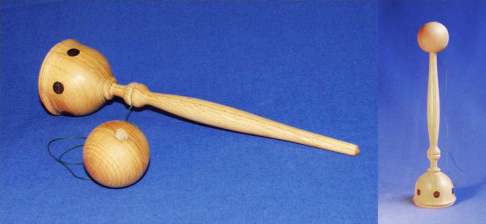 By boring holes in the wood and gluing in round sticks of wood in contrasting colours you can obtain a very simple and striking effect. To the right is shovn a toy made from beech with Brazilian rosewod glued in. The blank is turned round and maybe also shaped roughly before the holes are bored. Round dots of contrasting wood are obtained by boring perpendicular to the surface, oval by boring at an angle. The pieces of wood to glue into the holes are easily made on the lathe. The turning can be continued when the glue has dried.
By boring holes in the wood and gluing in round sticks of wood in contrasting colours you can obtain a very simple and striking effect. To the right is shovn a toy made from beech with Brazilian rosewod glued in. The blank is turned round and maybe also shaped roughly before the holes are bored. Round dots of contrasting wood are obtained by boring perpendicular to the surface, oval by boring at an angle. The pieces of wood to glue into the holes are easily made on the lathe. The turning can be continued when the glue has dried.
Colouring with wood
Stripes can be made by holding a narrow stick of some colour pigment containing woods hard against the rotating wood in the lathe. Ivory and wenge give dark colours, Brazilian rosewood gives a reddish colour. Purpleheart, padauk and probably many other woods may be also used.Carving
There are unlimited possibilities using carving to decorate turned items. I prefer narrow bands of geometrical patterns. Cuts the whole way through the wood are very striking, for example at the rim of a bowl.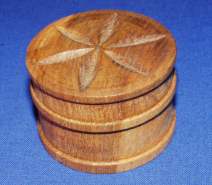
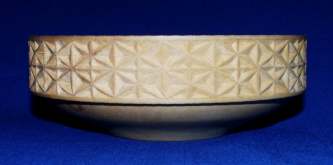
Painting, staining etc.
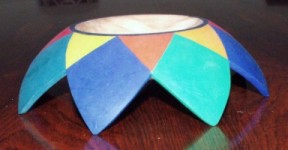 Paint can totally change the look of a turned object. Maybe it is a little difficult to make yourself paint your turned object, and, for sure, you can easilly ruin it with paint, but you can also obtain fantastic results, and a less good result may be changed by painting once more. Irene Grafert is a danish turner known for her use of colouring.
Paint can totally change the look of a turned object. Maybe it is a little difficult to make yourself paint your turned object, and, for sure, you can easilly ruin it with paint, but you can also obtain fantastic results, and a less good result may be changed by painting once more. Irene Grafert is a danish turner known for her use of colouring.
I have mainly used watercolours fixed with a coat of linseed oil when they are dry, but many types of paint may be used.
Cracking Cracked paint has been modern, but I don't feel like using it. However, some turners use it with impressive results. The effect is most easily obatined using special sets for cracked paint.
Colouring with iron acetate
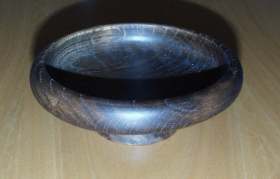 Colouring wood with iron acetate, Fe(CH3COO)2, is popular, probably because it's like magic to prepare your own clear liquid that totally changes the colour of the wood when applied. The colour obtained varies from dark brown and bluish colours to black, depending on the wood, and not alle types of wood are suited for the treatment - always make a test on a scrap peace of wood first. I don't really like the bluish colour shades and prefer using ammonia (see below).
Colouring wood with iron acetate, Fe(CH3COO)2, is popular, probably because it's like magic to prepare your own clear liquid that totally changes the colour of the wood when applied. The colour obtained varies from dark brown and bluish colours to black, depending on the wood, and not alle types of wood are suited for the treatment - always make a test on a scrap peace of wood first. I don't really like the bluish colour shades and prefer using ammonia (see below).
The recipe is simple: a piece of (used) steel wool or a handful of old iron nails and screws are put in a jam jar about half filled with vinegar. The day after the metal and the vinegar has formed iron acetate by a chemical process. The liquid is applied to the wood with a brush or a rag. The liquid may be thinned with water to obtain a lighter colour. The wood is coloured when the iron acetate reacts with tannic acid in the wood. Therefore, wood with a high content of tannic acid gives the best colouring. Oak and elm contins very much tannic acid and are therefore coloured much.
To obtain a more pronounced colouring, or for woods with a low content of tannic acid, tannic acid may be applied to the wood first. The tannic acid can be bought as powder (e.g. Brygland.dk maybe Vinøl Hobby) and is dissolved in water. The tannic acid is added to the water little by little until no more is dissolved.
After colouring with iron acetate the surface is left to dry and finally a finish with wax, oil etc may be applied.
A similar effect as with iron acetate should be obtained with iron(II) sulfate, which is among other used against moss in lawns and for dying wool, but I havn't tried it.
Ammonia
Oak can be coloured with ammonia vapours to colours from golden yellow-brown to warm dark brown and almost black. The technique is simple: the wooden object is placed in a container with lid together with a glass with a little ammonia water in it. The colour gets darker the longer the wood is fumed. It may take from hours to weeks depending on the desired colour. Large pieces can be fumed in a large closed plastic bag.Other types of wood than oak may be coloured with ammonia vapours. I havn't tried many and only oak with a good result. Some woods, e.g. pine, gets a grey colour as if it has been exposed to rain and sun for a long period, so it may be used for artificial ageing of such woods.
Colouring by heating
Wood gets darker when heated. Much heat for a longer period can char the wood, which is, of course, not desired.The treatment is done in an ordinary oven at about 200 degrees C for about 30 minutes - depending og wood species and the desired colour. Watch the colour regularly and stop when the desired colour is reached. The colour gets darker and the wood is (somewhat) protected against getting brittle if a very thin layer of oil is applied before heating. However, much heat can make the wood brittle anyway.
After the heat treatment, oil can be applied immediately, as the oil penetrates the hot wood better.
Leaf metal
Large surfaces with shiny metal is not to my taste, but i find a narrow golden stripe on dark wood very elegant. Real leaf gold and silver is expensive but aluminium, copper and gold coloured imitations of gold are cheap. The technique is simple. The area to be covered with metal is finished and a smooth coat (or more) of lacquer is applied. Shellac may be used. When the lacquer is dry the special glue for the leaf metal is applied. I use water based leaf metal glue that is the fastest to use but the oil based should give a more smooth surface. The leaf metal is applied when the glue has dried so that it is sticky but not wet. The leaf metal is cut to suitable size with a pair of scissors and then handled with a pair of tweezers with broad round tip. The metal is gently pressed to the surface with a brush or a rag. When the glue has hardened the excess metal is removed with a brush, a rag or very fine sandpapaer. Finally, the metal is covered with a layer of lacquer to prevent oxidation. Aluminium isn't lacquered as it doesn't change colour when oxidising and the lacquer will change it's colour.Before application, the leaf metal can be artificially aged if desired. Copper may be coloured blue or green in this process, but I haven't tried it. Copper leaf metal is also sold patinated to various colours.
Decoration using burning
Patterns and even pictures may be made using a burning tool for wood as the one used in schools. In my opinion, a soldering iron with a very fine tip at a higher temperature (about 500 C or even more) than for tin/lead-soldering is better.Burning with metal wire and steel cable
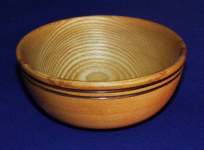 Burning stripes with metal cable is a well-known and simple technique. A small groove is turned where the stripe is ment to be. It should be a little narrower than the metal cable. Then, the metal cable is pulled firmly against the wood while the lathe is rotating so that the friction heat burns the wood. It is convenient to mount a small wooden handle in the ends of the piece of metal wire to make it easier to hold. The metal wire may also be mounted in a hacksaw.
Burning stripes with metal cable is a well-known and simple technique. A small groove is turned where the stripe is ment to be. It should be a little narrower than the metal cable. Then, the metal cable is pulled firmly against the wood while the lathe is rotating so that the friction heat burns the wood. It is convenient to mount a small wooden handle in the ends of the piece of metal wire to make it easier to hold. The metal wire may also be mounted in a hacksaw.
| Search my site: |
Copyright: You are welcome to copy and use photos and text for non-commercial purposes if you inform me first and make a comment with my name as reference next to the material copied.